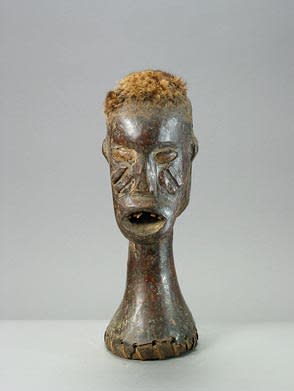Ekoi Wooden Janiform Crest Mask, 20th Century CE
Wood, Skin, Fur
5.25 x 16
PF.5933
Further images
The Ekoi people are best known for their large, skin-covered masks, which may have multiple faces. These masks are unique in Africa. Earlier in the tradition, the skins of slaves...
The Ekoi people are best known for their large, skin-covered masks, which may have multiple faces. These masks are unique in Africa. Earlier in the tradition, the skins of slaves were used; however, later masks utilized the skins of antelopes and other animals as in this fine example. Masks of secret societies appear in performances by accomplished dancers at funerals, initiations of new members, agricultural and other events. When the mask is made fresh animal skin is stretched and tacked over the soft wood from which it is carved. After the skin dried, it was stained with pigments made from leaves and bark. Two types of masks dominate: helmet masks and crest masks. The helmet mask covers the entire head of the wearer reaching to the shoulders. Crest masks, such as this one, do not cover the head but rather sit on top of it. They are attached to the basketry cap, which is held on the wearer’s head (notice the perforated holes at the base). The masks often have attached teeth, inlaid eyes, and frequently pegs to represent hair, which are often carved in elaborate coils; although, in this mask a short coiffure of animal fur is substituted. Feathers, quills, and other objects would have ornamented the mask in performance and disguised the identity of the wearer. It is presumed that all masks represented ancestors. In addition to masks that represent human heads, there are also those that represent skulls and animals. The skin covering of a mask served as a magical agent to invoke ancestral spirits, thus eroding the barrier between living and dead participants in communal rituals.





